Summer in northern Indiana, like many areas in the Midwest this year, had a rainy start. Unpredictable weather contributes to Rigg’s Outdoor Power Equipment’s biggest dealership challenge for the summer season. Rigg’s has locations in Valparaiso, Mishawaka, La Porte and Lafayette, Ind.
“A big challenge is knowing how much equipment to order for the season. Will rain drive early lawn and garden sales, but slow construction and light ag sales? It’s just our best guess,” says Jerry Klemczak, store manager at Rigg’s Mishawaka location.
Klemczak adds the challenge is similar for ordering parts. If it’s a dry summer and the grass isn’t growing, most likely the parts department will be slow since customers won’t be using their equipment as much, he explains. “However, dry is good for construction customers, which means they can start their projects and start billing which drives that part of the business in sales, parts and service.”
Finding the Right Mix
Since much of the equipment for the season is ordered in the winter, the process is part science, part “gut feeling.” He says, “We go through and look at past histories and what we’ve been selling for the last 3 years. So maybe we sold X amount 3 years ago and then we increased by 8% the next year, but the following year we dropped off maybe 10%. In those cases, you have to try to remember what the weather was like those years that might have impacted those changes. But, you always have that 3-year average that you’re going to order off. The trick is, do you order more or do you back off a little? It’s almost always a gamble,” explains Bryon Merritt, store manager at the La Porte location.
“You’ve got to try and get a good gut feeling for it. You can try and number crunch it to death, but unfortunately a lot of it is simply what does your gut say. If you’re a little high, you hope you have the fortitude to push it through and if you don’t, you pray you’ve got enough parts and service money backing it up to pay for it when it comes due. It’s a pretty tight rope to walk,” Merritt says.
Rigg’s Outdoor Power Equipment,
Mishawaka and La Porte, Ind.
Founded: 1981, with stores in Valparaiso, Mishawaka, La Porte and Lafayette, Ind.
Location: The Mishawaka store is located just off Highway 20 and the La Porte store is located off Highway 35. Each location serves residential, municipal, agricultural and commercial customers.
Lines: Kubota, Hustler Turf, Cub Cadet, Stihl, Dixie Chopper, Western, Land Pride, Toro Consumer and Honda Power Equipment
Challenge & Solution: Matching seasonal inventory to meet demand can be a challenge. Three years sales history is reviewed and reconciled with trends to make the best estimate. Inventory can be moved among the dealership’s 4 locations to meet demand.
“Fortunately, most of us have been doing this long enough that our guts have gotten pretty accurate. But, still, you take your computer hard facts and mix them with your gut feeling and just go for it,” says Klemczak.
In situations where sales exceed what was ordered, the stores work with the other locations to transfer equipment. “We share inventories every week. We have a truck and trailer and ship equipment from one store to the next,” Klemczak says. “If I’m out of something here in Mishawaka, but they have an excess of it at the Valparaiso store, they’ll shuttle some over here. We’re able to keep nearly all the models on hand that way.”
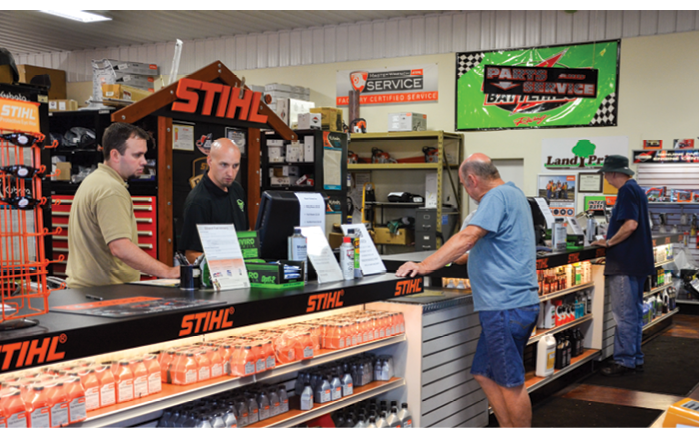
In addition to parts being available in each store, Rigg’s Outdoor Power Equipment sells parts online. Customers have the option of picking them up at one of the 4 store locations or having the parts shipped to them.
“Managing seasonal inventory is much more challenging than in other industries where the same product can sell all year round,” explains co-owner Geoff Blanco. “Inventory management is both science and art. The ‘gut feeling’ Jerry and Bryon are referring to is real-time information they hear from customers about their purchasing intentions or any trends they observe in buyer behavior. The critical part is backing up a gut feeling with ‘real science’ that ranges from sales history to preseason commitments from customers. The margin for error in a seasonal business considering millions of dollars of inventory that does come due is fairly slim. Mixing hard and soft data to form an inventory strategy allows you to be at the front end of a trend but also mitigate risk. Manufacturer incentive programs also play into the ordering equation.
“So if we buy semi-loads from a manufacturer, we’ll get it at an improved discount. If we go that route, then over the course of summer we do the fill-ins. Every week we’ll order certain models we may be out of,” he says. “The lawn and garden business is a bit more forgiving than snow because the selling season is longer. In the larger equipment business, it peaks in summer but has demand all year round to some level.”
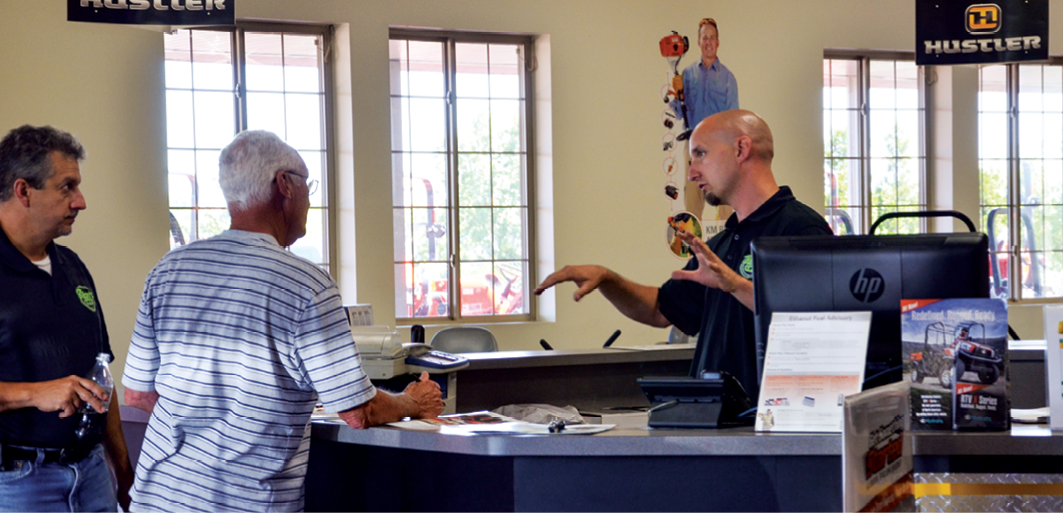
Jerry Klemczak (right), manager of the Mishawaka, Ind., store, and co-owner Geoff Blanco (left) discuss mower options with a customer.
In addition to the Kubota line, Rigg’s also carries Hustler Turf, Cub Cadet, Stihl, Dixie Chopper, Western, Land Pride, Toro Consumer and Honda Power Equipment.
Ordering the right amount and type of summer equipment, however, is much easier than winter equipment because the window of time for selling is so much longer on the lawn and garden side in the summer, Blanco says. “We’re used to ordering 500 mowers, but you can’t order 500 20-135 horsepower Kubota tractors. Then, you have to consider that each model might have 6 or more different variations. This is where sales history and communication is so important. Store managers identify the primary models sold, but also the trends in customizing those models from individual sales. The margin of error is extremely tough because a customer may come in and say, ‘You don’t have the right tractor with the right tires. I don’t want that one, I want this one.’ It’s a pretty big challenge,” Merritt says.
Mishawaka Store Achieves ‘Elite’ Status
For customers who are looking for a Stihl dealer through the manufacturer’s website, Rigg’s Outdoor Power Equipment’s Mishawaka, Ind., store will be at the top of the online results for those searching in the area. The Mishawaka store has earned Elite Dealer status with Stihl. To become an Elite Dealer, store manager Jerry Klemczak says a store must have exclusive product offerings, have a gold-certified technician and sell a certain amount of equipment every year.
In addition to being an Elite Dealer, the Mishawaka store has the largest Stihl display in the state of Indiana. Sales from the Stihl line make up about 10% of the company’s total revenues, but Klemczak says it accounts for the biggest investment in training. “We invest a lot into training because service goes with items like chain saws, trimmers and different trimmer heads. It takes a lot of training to know what goes on what model. So that’s probably one of the biggest challenges of getting people to realize what size file or what chain goes on that saw,” he says.
“Stihl takes a lot to sell well. You may need to explain to somebody the basics of a chainsaw. They may walk into the store and never had one before. You have to talk about how to start it, how to operate it safely, how to change a chain, why you need oil, do you need chaps, do you need helmet protection, there’s a lot that goes with that. It’s not just walking in and grabbing a chainsaw and saying, ‘See ya.’ And that’s why we do the in-depth training for that product line because it can be a dangerous tool.”
While some customers are willing to order equipment, Klemczak says that’s more the exception than the rule. “In my experience, if you don’t have it — with the right valve or the right tires — the customer may move on to the next dealer because of the ‘I want it now’ factor. Our long time customers will be more patient because they know we take good care of them, but occasionally we do get someone who will visit all the dealers in the area because he is set on buying today the tractor closest to his wish list,” Klemczak says.
Managing Used Inventory
Moving used equipment can be another challenge for Rigg’s, like it is for many dealers. While it’s easy to see the cash tied up in larger used equipment, Blanco says it’s the smaller lawn and garden products that can sneak up on you. “We’ve constantly got to be aware of how much our used inventory is, and on the lawn and garden side, that can add up quick into a whole bunch of small pieces. For example, one store maybe has 7 or 8 pieces in May and it doesn’t look so bad, but if you multiply that by 4 stores and everyone’s got 8 pieces, now the company has 32 pieces. If the average cost is $3,500, we have $112,000 of cash tied up and you’ve already paid on the back end for it and that is just lawn and garden,” he says.
For the larger equipment that Rigg’s sells, the dealership gets some assistance from Kubota on trade-ins. “On the ag and construction equipment side, we do have tools with Kubota to offset the cashflow impact because we can floorplan a trade. That’s huge for cashflow purposes for the dealer. If someone comes in and wants to trade in a 135 horsepower tractor, we’re going to give them say $40,000 in trade that’s money out of our pocket. So again, if you’ve got one of those tractors in each store, plus a couple of trackloaders and 40 used lawn and garden pieces, that is a significant amount of cash not funding operations. However, used equipment can also be some of our higher margin equipment sales, so turning it quickly means we recover our investment plus additional profit.”
Blanco says that if you’re a dealer who is considering adding larger equipment and you’re not used to that drain on cashflow, it can be really damaging. “In the beginning it was hard for us to adjust to that cashflow drain,” he says.
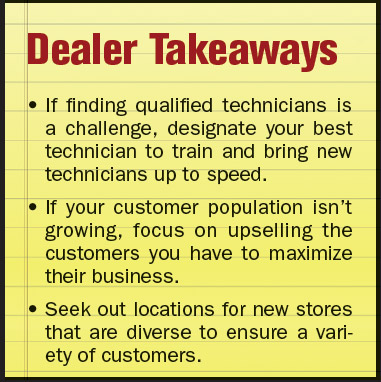
Moving Used Equipment
When it comes to moving used equipment, Blanco says Rigg’s has three methods. First, the higher value used equipment the dealership takes in is posted on the website (www.riggsdirect.com), which he says generates a lot of leads. The dealership also lists its used equipment inventory in magazines that serve the used equipment market. “For us, it’s the Auto and RV Trader magazine, which has a section specifically for our type of equipment. We’ve gotten a lot of leads that way,” Blanco says.
The third option for moving used equipment is through auction houses. “We’ve got wholesalers out there who will give us a buy-bid on it, usually that’s on bigger tractors and equipment. We can always move it that way if we need to — if things are getting tight,” Blanco says, adding it is a last resort option for equipment that has been sitting for more than a year.
“In general, we’re able to turn things pretty quickly, especially on the larger equipment but if we can floorplan a good portion of that, it really helps with cashflow. So it gives us an opportunity to hold onto used equipment longer and make our money back, and we have a better chance of making more money on it on the backside,” Merritt adds.
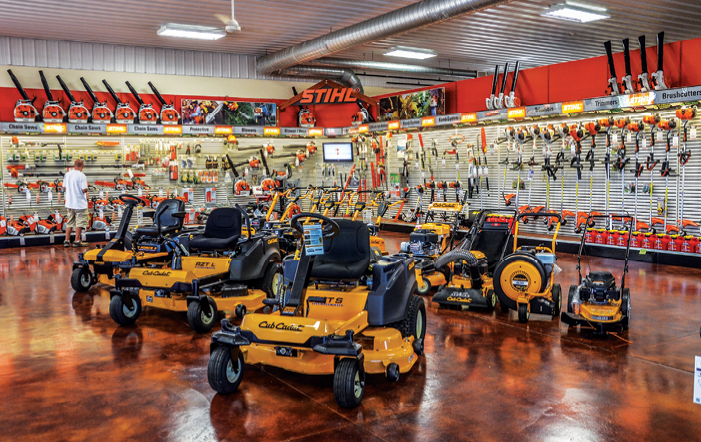

The Stihl display at Rigg’s Outdoor Power Equipment’s Mishiwaka, Ind., store is the largest in the state. The back side of the display serves as parts storage.
When it comes to the used tractor side of the business, Klemczak says hobby farmers or large property owners can get a bigger tractor than they would have if they had bought new. “They’re just not going to put the number of hours on it. If we’ve taken in a used Kubota tractor that’s got 1,500 hours on it, the residential large property owner will never again put that many hours on it,” he says. “It’s a great opportunity for them to get the bigger tractor that they wanted for the right money.”
Rigg’s Outdoor Power Equipment Strategically Locates Stores
All four of Rigg’s Outdoor Power Equipment’s stores are located near a university — Valparaiso Univ., Purdue Univ. and Univ. of Notre Dame. Co-owner Geoff Blanco says this is no coincidence. “We wanted to be in areas that weren’t dependent on one single industry,” he explains.
The universities keep enough business flowing through the region that if one industry takes a hit, there are enough others to keep people working and buying equipment. Universities coupled with business industry diversity also brings in a number of customer types for Rigg’s, including construction and landscaping contractors, rural lifestylers, large property owners and some suburban homeowners. Blanco describes the locations of the dealership’s stores as “the intersection of rural and suburban.”
In addition to listing used and new equipment inventory online, Rigg’s has also been selling parts through its website for the last 5 years. The dealership set up its website and ecommerce capabilities through ARI Network Services.
The business coming from the online offering has been somewhat surprising. “When we first started out, we thought our parts online business would mirror our over-the-counter business. It’s actually completely the opposite because you can get a Toro part, a Cub Cadet part, a Kawasaki part from a gazillion different places on the Internet because those parts are a commodity,” Blanco says.
Rigg’s gets more requests for Land Pride, Woods and Hustler parts, and more obscure lines which, Blanco says, are lines that aren’t as popular in different areas of the country. “When someone types in ‘Land Pride,’ we’re more likely to cycle to the first page of the search results than if someone types in Cub Cadet parts because there aren’t as many outlets selling Land Pride parts as there are for Cub Cadet.”
The prices for some parts are lower online vs. in the store because there is less overhead. “We don’t have to pay a person to diagnose the part the customer needs, look up the part, pull the part and do the transaction at the counter. When it comes through our website, the customer has already figured out what it is they need and are buying it. At that point, all we’re doing is taking it out of the bin and putting it on a shelf for pick up or in a box and shipping it,” Blanco says.
Some commercial customers have figured this out and will purchase the piece online and then come into one of our stores to pick it up. “And that’s great for us, too. On a
“We’re used to ordering 500 mowers of a particular brand; you can’t order 500 Kubotas...”
day like today when there are 15 people out there, if we can take 5 people out of the mix, we’re still selling our parts and taking care of customers faster, so customer satisfaction is better at the counter,” he says.
Rigg’s has seen its web traffic continue to grow as consumers do more research and buying on the Internet. “As a result, we’re seeing more ‘click-throughs’ on our used equipment and online parts pages,” Blanco says.
Filling a Labor Void
Finding service technicians who can work on both small outdoor power equipment as well as larger equipment such as tractors, has been a challenge for Rigg’s Outdoor Power Equipment. The dealership puts a lot of focus on each service technician’s billed time. “We monitor billable time for each mechanic every week with a minimum threshold of 85%. If a mechanic is below that percentage, the store manager has to justify why. This helps us identify issues in our processes or training needs. It also lets us know when to hire if we are consistently in the 90% range, and still more than a week out consistently, we can justify another technician. On the flipside, we can quantify if we have more capacity than we have demand and can adjust accordingly,” says co-owner Geoff Blanco.
To improve their technical ability across all stores, Rigg’s is creating a new service field technician position.
“We’re in the process of taking one of our best mechanics in the company, Mark Ratliff, who’s our shop foreman in Valparaiso, and pulling him out of that capacity and having him go store to store to train and get the ‘green guys’ up to speed in certain areas as well as get equipment out the door faster,” Blanco explains.
“So if we’ve got a Kubota split apart and the tech is just stuck on it, that customer is saying ‘Where’s my Kubota?’ We want to get Mark in there for a training opportunity, improve customer response time and increase shop efficiency. Then, the next time a tractor is split apart like that, he says, ‘Yeah, I can do this again.’ ”
Rigg’s isn’t selling wholegoods online because they want customers to come in to ensure they are getting the right equipment. “That way we don’t have returns. We don’t have a customer buying something online and bringing it back and saying, ‘This isn’t what I wanted’ and we’re stuck with something that is used in some form. We get them in the store and we get them the right piece of equipment the first time around as well as upsell and cross sell them, increasing our take of their overall equipment spend,” Blanco says.
Stuck in the Middle
Rigg’s La Porte store is nestled about halfway between the Valparaiso and Mishawaka locations, which creates some unique challenges, says Merritt. La Porte is about 30 miles from the other 2 locations and sometimes draws customers that might live 4 or 5 miles into the other’s territory. “They might travel one way or the other based on where they work or where their family is. We try and not ‘step on each other’s toes’ and make sure we’re doing what we can in our county to gain as much government and municipal business as we can,” Merritt says. Each of the stores works off the same pricing structure, so they don’t compete against each other.
Merritt tries to determine where the customer lives early in the conversation to make sure they’re shopping at the closest location. “I’ve tried to build it into my standard approach, asking where they live or what their phone number is and working off the area code,” he says. “I am very adamant about telling them if they live closer to one of the other stores that is most likely where they’ll end up doing their service and going for parts. I tell them, ‘If you’re going to be over that way more often, you probably should consider doing your business there.’ Ultimately, it’s the customer’s decision and we are happy to take care of them at any of our stores.
“I want to make sure they understand that we’re all the same company, so it’s a lot easier for the guys to keep track of who the customer is if the equipment is bought and serviced in the same store,” Merritt says.
Another challenge for the La Porte store is a stagnant customer base. Over the last 10 years, the population of 22,000 people has varied by only about 1,000 people, Merritt says. “That’s basically zero growth within the town we operate,” he says. “The Valparaiso and Mishawaka stores are in areas where there’s a growth pattern, so they do have to focus on market share and growing with the expanding area. Whereas over in my ‘neck of the woods,’ it’s making sure that we soak up as much of the local community as we can because there just simply isn’t much growth there at all.”
Merritt says to help the store grow they’ve put more focus on process, especially on the service side of the business. “Not only has it created a happier customer for us based on the way we operate, but it’s also given us an opportunity to increase dollars per customer. It’s more about upselling and making sure the customer gets what they need when they’re here. It’s maximizing what we’re getting out of each individual customer because I can’t say that our customer count would be up or down from one year to the next,”
Merritt says.

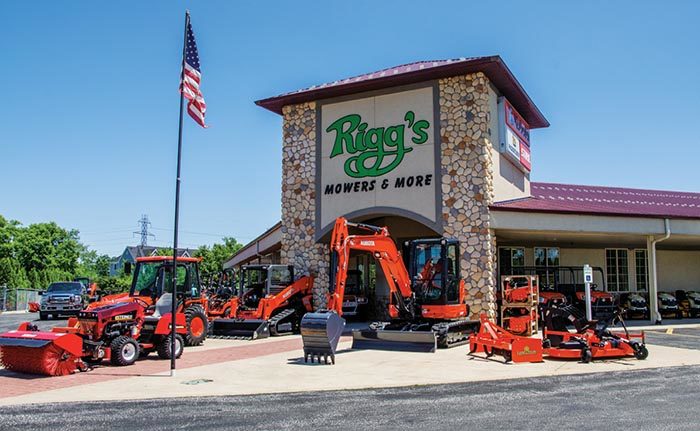




Post a comment
Report Abusive Comment